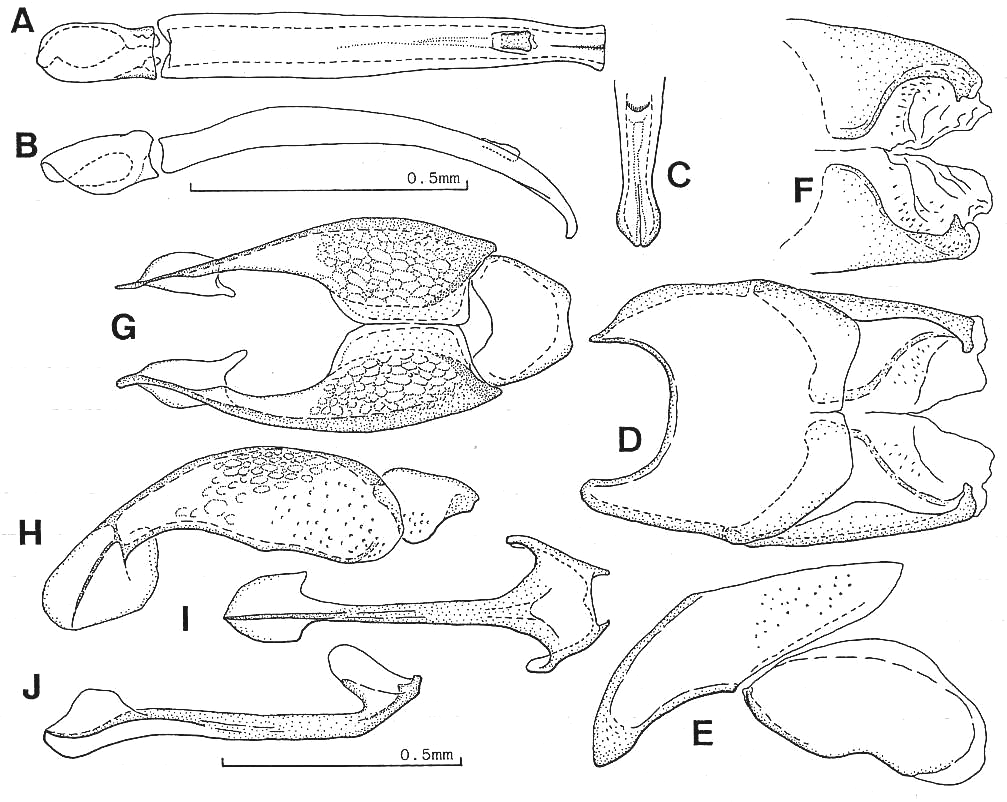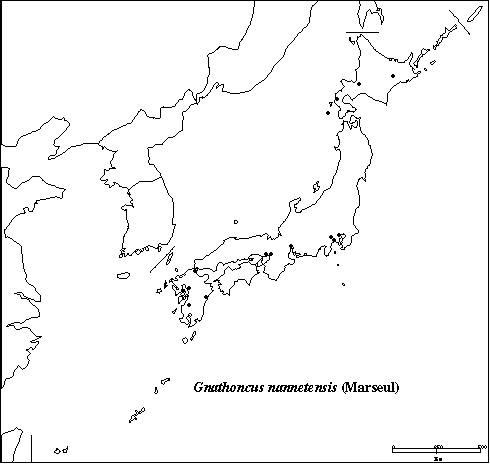
Saprinus nannetensis Marseul, 1862: 499, fig. 2 [IVe groupe]; Reitter, 1896: 308; Auzat, 1917: 208; Reichardt, 1941: 160, 162; Hinton, 1945: 316, 325; Stockmann, 1957: 60, 73; Witzgall, 1971: 166.
Gnathoncus rotundatus: Thomson, 1862: 242 nec Kugelann, 1792, corrected by Reichardt, 1941: 162; Schmidt, 1885: 317; Ganglbauer, 1899: 379; Reitter, 1904: 36; 1909: 291; Reclaire and van der Viel, 1936: 234; Horion, 1949: 45.
Hister rotundatus var. "a": Hoffmann, 1803: 87, synonymized by Reichardt, 1941: 162.
Gnathoncus urganensis Reitter, 1896: 307; 1904: 36, synonymized by Bickhardt, 1916: 105.
Gnathoncus rotundatus var. suturalis: Ganglbauer, 1899: 380, synonymized by Bickhardt, 1916: 105.
Gnathoncus rotundatus var. nannetensis: Roubal et Labler, 1933: 30.
Gnathoncus nannetensis: Gemminger et Harold, 1868: 792; Kryzhanovskij and Reichardt, 1976: 117; Mazur, 1980: 91; 1984: 105; Vienna, 1980: 121; Hisamatsu, 1985: 222; Yélamos, 1990: 79.
Gnathoncus nannetensis: Ôhara, 1994, 215.
Gnathoncus nannetensis: Ohara, 1994, 215.
Description. Body length, PPL, male, 2.33 - 3.43 mm (2.73 ± 0.06, n=20), female, 2.77 - 3.48 mm (3.10 ± 0.04, n=20), PEL, 2.21 - 3.31 mm (2.57 ± 0.06, n=20), female, 2.47 - 3.14 mm (2.89 ± 0.04, n=20). Width, male, 1.72 - 2.47 mm (2.04 ± 0.04, n=20), female, 2.13 - 2.50 mm (2.31 ± 0.02, n=20). Biometeric data are given in Table 42. Body broadly oval and strongly convex. Cuticles shining and black; antennae dark rufopiceous with club rufotestaceous; legs dark reddish brown.
Front sparsely clothed with deep and moderate punctures.
Pronotal sides (Fig. 126A) feebly arcuate and convergent on basal two-thirds, thence strongly convergent to apices. Apical angles obtuse. Marginal stria carinate and complete. Middle of disk moderately punctate, the puctures being separated by two to four times their diameter, becoming coarser and denser twoards sides; base with a single or double transverse rows of punctures which are nearly as coarse as those on sides. Interspace among punctures smooth and with occasional microscopic punctures.
Epipleura of elytra not concave. Marginal epipleural stria finely impressed and complete. Another epipleural stria complete, carinate and well impressed between the marginal epipleural and elytral striae. Marginal elytral stria complete, carinate and its apical end extending across elytral apex to medio-apical angle of elytra, then a little extending basally. Surface of epipleura between the marginal epipleural and other striae smooth, and with several fine punctures medially; surface between other epipleural and marginal elytral striae with a row of coarse punctures. Internal subhumeral stria present on medio-apical fourth. Oblique humeral stria present on basal third and usually crossed by a number of fine oblique rugae so that it appears to be irregular. First dorsal stria deeply impressed and nearly complete. Second and 4th striae deeply impressed and present on basal half. Third stria a little longer than the 2nd. Fifth stria only represented by a short, curved, transverse line at base. Sutural stria confined to basal region, usually present on basal sixth. Surface of apical half or three-fifths of elytra covered with deep oval punctures which are about as coarse as those on the extreme base of the pronotum and separated by their own diameter to twice the diameter; surface of basal half to two-fifths slightly more finely and more sparsely punctate than middle of pronotal disk; extreme apex of elytra (around apical stria) impunctate. Interspace among all discal elytral punctures smooth or nearly so.
Propygidium densely with coarse punctures on apical half, which are as large as those occuring anteriorly to the apical elytral stria, and more finely and more sparsely punctate on basal half. Interspace among the punctures with lightly impressed, fine and irregularly transverse lines, these lines heavily impressed on basal half. Pygidium coarsely and sparsely covered with round and umbilicate punctures, which are separated by their own diameter to twice the diameter; on apex those punctures are much finer.
Anterior margin of median portion of prosternum (Fig. 127A) round. Ventral disk of keel even, somewhat broad, and sparsely and moderately punctate. Carinal striae complete, carinate and sinuate, the anterior apex of striae attaining to a large preapical fovea. Descending lateral stria shortly present on medial third of prosternum, its medio-apical end attaining to apical third of length of keel.
Anterior margin of mesosternum bisinuate with a feeble median projection. Marginal stria of mesosternum complete and subcariniform. Disk sparsely and coarsely covered with transverse and setiferous punctures, and interspace among punctures sparsely with microscopic punctures. Meso-metasternal suture indistinctly impressed and accomparnied by a coarsely crenate line. Median area of intercoxal disk of metasternum sparsely clothed with fine and setiferous punctures, the punctures being separated by four to seven times their diameter; anterior corner sparsely with large and setiferous punctures, the puncuters being sparser and finer on mediolateral area; posterior corner evenly covered with coarse punctures, which are separated by about twice their diameter. Lateral metasternal stria carinate and deeply impressed on lateral two-thirds of the intercoxal disk, an area inside the stria bearing coarse punctures. Lateral disk densely covered with large, round, shallow and setiferous punctures. Metepisternum more densely covered with large punctures than those of lateral disk.
Intercoxal disk of 1st abdominal sternum completely striate, the stria carinate, running along post-coxal cavity on basal half and straight towards posterior margin on apical half. Surface of disk sparsely and coarsely punctate, the punctures being finer on median area.
Protibia (Fig. 126D) with 9 spinules on outer margin.
Table 42. Biometeric data of Gnathoncus nannetensis (Marseul).
-------------------------------------------------------------------------------------------------------------------
Male Female
-------------------------------------------------------------------------------------------------------------------
APW 0.66-0.93 (0.77±0.01) 20 0.81-0.93 (0.87±0.01) 20
PPW 1.52-2.11 (1.78±0.03) 20 1.86-2.21 (2.01±0.02) 20
PL 0.81-1.08 (0.91±0.01) 20 0.88-1.15 (1.00±0.02) 20
EL 1.27-1.91 (1.58±0.03) 20 1.57-1.94 (1.77±0.02) 20
EW 1.72-2.47 (2.04±0.04) 20 2.13-2.50 (2.31±0.02) 20
ProW 0.98-1.35 (1.11±0.02) 20 1.10-1.47 (1.29±0.02) 20
ProL 0.17-0.25 (0.20±0.01) 20 0.17-0.29 (0.23±0.01) 20
PyL 0.74-1.13 (0.92±0.02) 20 0.86-1.13 (1.04±0.02) 20
PTL 0.59-0.78 (0.65±0.01) 20 0.64-0.81 (0.71±0.01) 20
MSTL 0.61-0.78 (0.71±0.01) 20 0.69-0.86 (0.77±0.01) 20
MTTL 0.71-0.93 (0.81±0.01) 20 0.78-1.03 (0.91±0.02) 20
-------------------------------------------------------------------------------------------------------------------
Male genitalia as shown in Fig. 128.

Ohara (1994: Fig. 128)
Remarks. Gnathoncus nannetensis is a relatively large species; it is similar to G. rotundatus and G. communis, but distanguished by the different shape of the punctutres on the pygidium and by the presence of the apical excavation of the prosternal keel (see the key and descripton).
This cadavericole and coprophile species frequents a wide range of habitats;
it occurs on decomposing bodies of chicken, on dung of pig and cow, and
so on. It is also found in nests of birds, the fish owl Ketupa blakistoni
(Seebohm) and the swallow Hirundo rustica Linné, for example. Mazur
(1981) recoded this species from the nests of the following birds and animals:
carrion craw, Corvus corax L.; jackdaw, Corvus monedula (L.); starling,
Sturnus vulgaris L.; swift, Apus apus (L.); blue tit, Parus caeruleus L.;
rough-legged buzzard, Buteo lagopus (Brunn); wood pigeon, Columba oenas
L.; dadger, Meles meles L., and Laetiporus sulphureus (Bull. et Fr.).
[Hokkaidô] 3 exs., Futatsu-yama, Shibecha, Kushiro, 3/v/1985, K. Ijima leg. (IJ); 1 ex., Bekkambe-dai, Shibecha, Kushiro, 26/v/1971, K. Ijima leg. (IJ); 1 ex., Usubetsu, Taisetsu-chô, 22/vii/1954, K. Sawada leg. (NA); 1 ex., Nopporo, 10/v/1987, M. Ôhara leg.; 59 exs., Ashoro, 30/v/1989, Y. Hayashi, N. Kuhara and O. Suda leg. (from a nest of an owl, Ketupa blakistoni).
[Honshû] <Kanagawa-ken> 6 exs., Bodai, Tanzawa, 8/iv/1973, Y. Hirano leg. (NA); 3 exs., Ditto, 3/iii/1974, Y. Hirano leg. (NA); 1 exs., Hatano, Kanagawa, 1/ix/1978, H. Takizawa leg. <Yamanashi-ken> 1 ex., Narusawa, Fuji, 31/v/1983, M. Abe leg. (NA). <Aichi-ken> 1 ex., Okehazama, Owari, i/1946, M. Yasuda leg. (NA). <Ôsaka-fu> 2 exs., Nishinari-ku, 2/vii/1949, K. Sawada leg. (NA). <Tottori-ken> 1 ex., Takenouchi, 4/iv/1987, H. Daidô leg.
[Kyûshû] <Fukuoka-ken> 1Åâ, Mt. Adachi, 25/v/1978, S. Nakao leg. (NA); 1 ex., Matsunoe, Moji, 4/v/1936, S. Watanabe leg. (NA). <Kumamoto-ken> 1 ex., Uemura, Kuma-gun, 6/vi/1986, K. Kimura leg. (NA); 16 exs., Yokoshima, Tamana, 9/vi/1986, E. Matsui leg. <Miyazaki-ken> 1 ex., Nobeoka, 7/iv/1982, T. Kinoda leg.; 12 exs., Furushiro-chô, Nobeoka, 4/vi/1985, T. Kinoda leg.
[Sachalin] 1 ex., Muka, 20/vii/1944, Y. Nishijima leg. (EIHU).
Distribution (Fig. 131). Japan (Hokkaidô, Honshû, Shikoku, Kyûshû); nearly the whole Palearctic. New to Hokkaidô.
[Hokkaido] Oshima-Oshima Is.: Yamase-domari (1 ex., 25/vi/1994, NIS), H. Nishijima.
[Honshu] Tokyo-to: Tokyo (8 exs., iv/1995, collected from inside of the storehouse of a paper-manufacturing company). Hyogo-ken: Foot of Mt. Maya (1 ex., 6/iv/1938), K. Kurosa.
